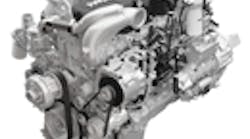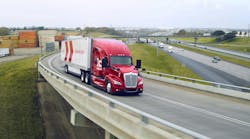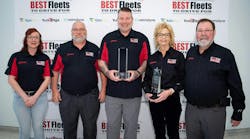Global truck and engine builder Paccar Inc., the parent of Kenworth Truck Co. and Peterbilt Motors, plans to roll out its new MX diesel engine in the U.S. this summer. The MX was developed for powering both Peterbilt and Kenworth truck models.
MX engines will be imported from Paccar’s European truck subsidiary, DAF Trucks, and will be equipped with selective catalytic reduction (SCR) technology to comply with EPA 2010 emission regs. The powerplants will be available in a range between 380 and 485 horsepower and will boast up to 1,750 ft-lbs of torque, making them suitable for use in both over-the-road and vocational applications, the company said.
Craig Brewster, Paccar assistant vp,said that the MX engine block and cylinder heads are manufactured from high-strength compacted graphite iron (CGI). He said an electronically controlled high pressure fuel injection system helps maintain fuel economy and achieve the low emission targets required by the EPA 2010 standards.
Paccar first showcased the European technology that the MX is based on in late 2007 during media briefings held at the OEM's DAF/Leyland assembly plant in England and at its DAF truck factory in The Netherlands. At that time, Paccar said it was planning to build the MX at a $400 million, 420,000-sq.-ft. factory in Columbus, MS, starting in 2009. But put that plan was put on hold once the global economic recession hit and North American engine production was shifted to its DAF plant in Eindhoven, Holland.
“I think we obviously have capacity in Europe with the slowdown there; we are going to utilize that,” Paccar chairman & CEO Mark Pigott told financial analysts in a conference call in early 2009.. “We essentially have a new engine factory in Europe that was built about four years ago that's state-of-the-art, so we'll manufacture there. The buildings in Mississippi are essentially complete and it is a first-class facility that when the market recovers, we're looking forward to utilizing.”
Paccar’s move to offer a proprietary engine line follows the lead of other OEMs in the North American market – Daimler Trucks North America (DTNA), Navistar, and Mack Trucks and Volvo Trucks North America – that have rolled out such engine lines recently so they could offer more highly integrated trucks.
Eric Starks, president of research firm FTR Associates, suggests Paccar is seeking more business from its core customer base by offering a proprietary engine just as its competitors do. “It’s easier to configure your trucks if you control the entire engineering process, from chassis to engine,” he explained to FleetOwner. “But the aftermarket business for parts and service when it comes to engines is really big” as well.
Starks added that having a proprietary engine line also provides a safety net of sorts. “The concern [for OEMs]is about whether independent engine manufacturers go away completely,” he said, pointing to the withdrawal of Caterpillar from the heavy-truck engine market in June 2008.
For those who sell Kenworth and Peterbilt trucks, the arrival of the long-awaited MX is welcome news. “We are very excited about the MX engine launch this summer and our ability to offer a proprietary engine for Peterbilt,” Rusty Rush, president & CEO of Peterbilt dealership chain Rush Enterprises, Inc., told FleetOwner.
“I’m very confident about this engine; it is built from the same platform and in keeping with the long line of engines that Paccar has been producing in Europe for fifty years,” he said. “We believe the MX will offer advantages in durability, lighter weight, fuel economy and noise reduction along with powerful performance ranges and ease of maintenance. The engine has also been tested in North America for several years; we have worked with several fleets during that process and test results have been excellent.




